MISTERIOUS CRESTS
By V.Filippov (Moscow, Russia)
Typographer of magazine "Cacti and others"
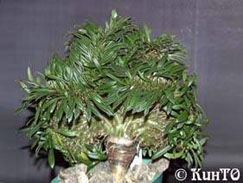 |
| Photo 1. |
You will never skip crests in any collection containing plants of different shapes and colors. Their unusual look and charm will draw your attention. (photo 1 Pachypodium lamerei).
In this article I will try to summarize facts from different publications concerning the origin of fasciations. (Ugly deformation of stems shown as accretion in several points and/or extension of one of them). I should say that there is no described 100% successful method of growing crests. I mean published methods when repeated did not have the same results. But there are lots of articles where authors having particular examples of forming crests tried to build theories about their origin. The problem is that they had only consequences handy, not succession of facts. We will look at some of these theories here.
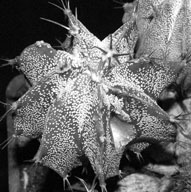 |
| Photo 2. |
So, what factors according to the authors contributed to developing crested forms? Many of them believe that crests are the result of a decease appeared after the plant was injured or the normal feeding of tissues was broken (hypertrophy). They mean cases when the plants were injured by pets and parasites sucking juice and laying eggs in the body of the plant. In fact ticks happen to reproduce so abundantly on the plant that the growing point dies and the plant suspends growing. Then it starts developing lateral offsets from areoles including crests. One can come across crest whose lower part is covered with rusty spots - the traits of previous tick attacks. Is it the cause of the fasciation or the owner's negligence?
Many "cacti hunters" say that where you find one crest you can find more near including the ones belonging to other species. This fact is the ground for considering mechanical injury as the cause for forming crests (especially if there are rocks nearby or the place is used as a pasture). Another cause is believed to be auxin poisoning in the result of contamination with fungi. By the way, speaking of mechanical injury of growing point I should mention the following experiment.
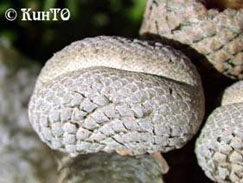 |
| Photo 3. |
An Echinopsis multiplex was cut by the knife vertically into four parts joined in the lower part. To prevent them from accretion a piece of wood was placed in the middle. Some time later two parts formed crests. Unfortunately, Mr. Wolthuys (J.J.Verbeek Wolthuys "Monstrosity and crestation in succulent plants") failed to repeat the experiment. I decided to make it myself with the help of 3-years old Astrophytum ornatum. I cut it in a similar way and placed a 1-cm diameter pebble in the middle. It is early to make any conclusions but the plant seems to surround the foreign body, and there are no signs of crest (photo 2). I made another experiment with a young seedling of Astrophytum ornatum grafted into a peresliopsis. All the four parts gave a normal offset from the top.
Probably just mechanical injury is not enough and it requires contamination. But what kind of contamination? What is biochemical difference of crest tissues from normal ones? Is it possible to inject crestation?
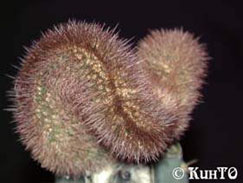 |
| Photo 4. |
Not being a biologist I decided to make this question clear for myself. I cut a piece of crest, crumbled it up, mashed it and got juice with pulp. Using a syringe with a thick needle I injected the juice about 7-10 mm deep into the growing point of one of the A.ornatum seedlings. The result is as follows: the growing point seems to be alive, the seedling is going on growing without any changes. May be again it is early to speak of the results?
OK, "the injection of crestation" gave no results. Is it possible to achieve the desired effect using chemicals? I mean just poisoning plants? There are cases described when similar actions led to the desired result. C&SJ 1(2) published an article about Opuntia cylindrical that formed a crest after it was poisoned with arsenic solution. Wolthuys described his attempts to poison 12 seedlings of Echinopsis using different chemicals, including salt, soda and others. The plants grew stunted or rotted, but two of them survived. One of them formed normal offsets, the other - crests. Eight years later he repeated the experiment injecting water, lactic, oxalic and formic acid, and other chemicals. Most plants died again.
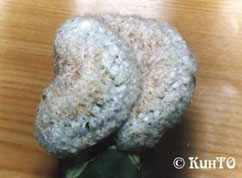 |
| Photo 5. |
There are cases when plants formed crests as they grew very fast and abundantly because of the soil rich in nitrogen. That means this is the break of tissues feeding that can lead to fasciations. For instance, a plant formed crests after it was kept unplanted for 3 years. Both previous and this case are examples of shock therapy.
Let me quote Professor Salisbury from London University who explains this phenomenon (1939): "Fasciation usually occurs when the period favorable for photosynthesis but unfavorable for growth is accompanied by factors contributing to active growth (e.g. high humidity)". But it turned impossible to repeat (or prove) the experiment. Some of Wolthuys' plants grew better, some species of Echinopsis formed offsets, but there was no fasciation.
I would like to mention the experiment fulfilled by A.P. Sokolov, Alma-Ata, in 1972 when he kept 200 4-months old seedlings of Rebutia senilis v.stuemeri in the sun at +40°С for 20 to 30 minutes and in the refrigerator at 10-15°С for 3 to 4 minutes in 5 turns. Only 19 seedlings survived, 9 of them formed offsets in abundance including crest like fragments, and 2 of them formed true stable crests.
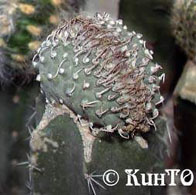 |
| Photo 6. |
You might see cacti having lots of offsets cramped by each other. Some of them become flat and have slit-like top. One can think it is enough to cut out such an offset, graft it and receive a crest.
But what if we try to develop this idea presented us by the nature artificially? For my experiment I cut out one of the offsets from headless Coryphantha elephantidens, grafted it and pressed it between two steel plates. To stimulate the plant to grow in the necessary direction I cut lateral offsets. The plant was kept this way for about a year but it gave no desired result. It did not lack feeding, it surrounded the obstacle and continued to develop normally.
May be this is high sun activity, hard radiation penetrating through the ozone layer and raising background radiation for a while that matters? I decided to check this idea using the means handy. First I affected seeds with ultraviolet. In 1993 I used a 15 megawatt/сm2 source with wave-length 254 nm to irradiate a portion of Parodia cardenasii seeds with 20 seconds interval. Then I sowed them together with a control group. I can not say I got no results, but they were not what I hoped to get. This year I repeated the experiment to reveal regularities. This time I used Melocactus matanzanus seeds. I never got crests but found that small portions of UV rays stimulate germinating capacity of seeds. And then the bigger the portions the smaller is the percent of germination. At the level of 5% rare low chlorophyll seedlings appear. This experiment and the one below can not be considered finished as mutations can show later.
As I was not satisfied with ultraviolet rays I thought that I had nothing to lose and decided to try X-radiation. For this purpose I took seeds of M.matanzanus. I used apparatus REIS-100 having voltage of 85 kilovolt and current of 25 microampere. The seeds were irradiated by absorbed dose rate of 20 rad per second. The first portion of seeds was irradiated by 1 kilorad in autumn 1998, the other - 800 rad in spring 1999. In both portion only about 10 percent of seeds survived. Now, a year later, the seedlings are quite normal. But there were certain results: about 30 percent of seedling had reddish brown sort of dried out cotyledons, they died in a couple of days without forming roots. My attempts to graft them failed.
Then I tried to irradiate strong seedlings. I chose Ariocarpus kotschoubeyanus. Each pair was assigned values from 20 to 120 rad with interval of 20 and got irradiated according to the values. Then they were grafted into pereskiopsis. The only result yet is their slow growth.
I should say that all the described attempts to get fasciations of succulent plants artificially are of academic character from a collector's point of view. The task is not just get a crested form, it should be stable!
Is fasciation inherited? This is the question that lots of crest fanciers are interested in. There is data that about 10% of seedlings get crested with time. I can not prove or disprove it as I sowed the seeds from crested forms got by J. Lode only in 2000 and the seedlings are too small yet to judge though they look normal.
In magazine "Kaktusarske Listy", 1950, I read about Cenek Zagradnik from Prague who sowed the seeds of autogamous crested Gymnocalycium michanowichii and got more than 50% of crested seedlings. According to the above mentioned fact natural crestation is not so rare.
So, I can draw the following conclusions:
- Do we know the nature of crest? - No!
- Can any cactus fancier get a crested form at home? - No! At least as far as we get the answer to the first question and if we exclude a lucky chance.
- Is it possible to get a crest in the laboratory? - Sometimes it is, but the percentage of cull and the expenses will be rather high.
Photo from the magazine.





